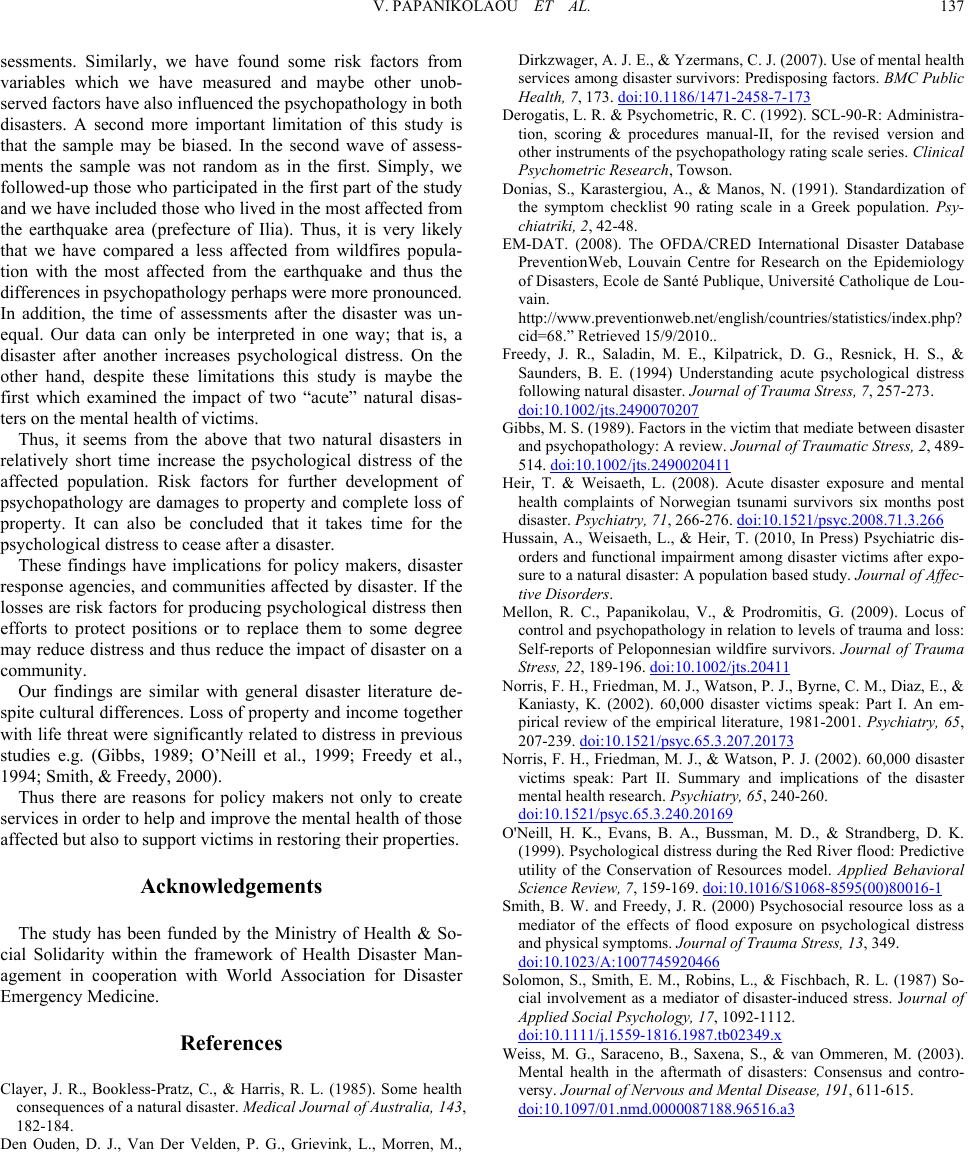
V. PAPANIKOLAOU ET AL. 137
sessments. Similarly, we have found some risk factors from
variables which we have measured and maybe other unob-
served factors have also influenced the psychopathology in both
disasters. A second more important limitation of this study is
that the sample may be biased. In the second wave of assess-
ments the sample was not random as in the first. Simply, we
followed-up those who participated in the first part of the study
and we have included those who lived in the most affected from
the earthquake area (prefecture of Ilia). Thus, it is very likely
that we have compared a less affected from wildfires popula-
tion with the most affected from the earthquake and thus the
differences in psychopathology perhaps were more pronounced.
In addition, the time of assessments after the disaster was un-
equal. Our data can only be interpreted in one way; that is, a
disaster after another increases psychological distress. On the
other hand, despite these limitations this study is maybe the
first which examined the impact of two “acute” natural disas-
ters on the mental health of victims.
Thus, it seems from the above that two natural disasters in
relatively short time increase the psychological distress of the
affected population. Risk factors for further development of
psychopathology are damages to property and complete loss of
property. It can also be concluded that it takes time for the
psychological distress to cease after a disaster.
These findings have implications for policy makers, disaster
response agencies, and communities affected by disaster. If the
losses are risk factors for producing psychological distress then
efforts to protect positions or to replace them to some degree
may reduce distress and thus reduce the impact of disaster on a
community.
Our findings are similar with general disaster literature de-
spite cultural differences. Loss of property and income together
with life threat were significantly related to distress in previous
studies e.g. (Gibbs, 1989; O’Neill et al., 1999; Freedy et al.,
1994; Smith, & Freedy, 2000 ) .
Thus there are reasons for policy makers not only to create
services in order to help and improve the mental health of those
affected but also to support victims in restoring their properties.
Acknowledgements
The study has been funded by the Ministry of Health & So-
cial Solidarity within the framework of Health Disaster Man-
agement in cooperation with World Association for Disaster
Emergency Medicine.
References
Clayer, J. R., Bookless-Pratz, C., & Harris, R. L. (1985). Some health
consequences of a natural disaster. Medical Journal of Australia, 143,
182-184.
Den Ouden, D. J., Van Der Velden, P. G., Grievink, L., Morren, M.,
Dirkzwager, A. J. E., & Yzermans, C. J. (2007). Use of mental health
services among disaster survivors: Predisposing factors. BMC Public
Health, 7, 173. doi:10.1186/1471-2458-7-173
Derogatis, L. R. & Psychometric, R. C. (1992). SCL-90-R: Administra-
tion, scoring & procedures manual-II, for the revised version and
other instruments of the psychopathology rating scale series. Clinical
Psychometric Research, Towson.
Donias, S., Karastergiou, A., & Manos, N. (1991). Standardization of
the symptom checklist 90 rating scale in a Greek population. Psy-
chiatriki, 2, 42-48.
EM-DAT. (2008). The OFDA/CRED International Disaster Database
PreventionWeb, Louvain Centre for Research on the Epidemiology
of Disasters, Ecole de Santé Publique, Université Catholique de Lou-
vain.
http://www.preventionweb.net/english/countries/statistics/index.php?
cid=68.” Retrieved 15/9/2010. .
Freedy, J. R., Saladin, M. E., Kilpatrick, D. G., Resnick, H. S., &
Saunders, B. E. (1994) Understanding acute psychological distress
following natural disaster. Journal of Trauma Str ess , 7, 257-273.
doi:10.1002/jts.2490070207
Gibbs, M. S. (1989). Factors in the victim that mediate between disaster
and psychopathology: A review. Journal of Traumatic Stress, 2, 489-
514. doi:10.1002/jts.2490020411
Heir, T. & Weisaeth, L. (2008). Acute disaster exposure and mental
health complaints of Norwegian tsunami survivors six months post
disaster. Psychiatry, 71, 266-276. doi:10.1521/psyc.2008.71.3.266
Hussain, A., Weisaeth, L., & Heir, T. (2010, In Press) Psychiatric dis-
orders and functional impairment among disaster victims after expo-
sure to a natural disaster: A population based study. Journal of Affec-
tive Disorders.
Mellon, R. C., Papanikolau, V., & Prodromitis, G. (2009). Locus of
control and psychopathology in relation to levels of trauma and loss:
Self-reports of Peloponnesian wildfire survivors. Journal of Trauma
Stress, 22, 189-196. doi:10.1002/jts.20411
Norris, F. H., Frie dman, M. J., Wats on, P. J., Byrn e, C. M., Diaz, E., &
Kaniasty, K. (2002). 60,000 disaster victims speak: Part I. An em-
pirical review of the empirical literature, 1981-2001. Psychiatry, 65,
207-239. doi:10.1521/psyc.65.3.207.20173
Norris, F. H., Friedman, M. J., & Watson, P. J. (2002). 60,000 disaster
victims speak: Part II. Summary and implications of the disaster
mental health research. Psychiatry, 65, 240-260.
doi:10.1521/psyc.65.3.240.20169
O'Neill, H. K., Evans, B. A., Bussman, M. D., & Strandberg, D. K.
(1999). Psychological distress during the Red River flood: Predictive
utility of the Conservation of Resources model. Applied Behavioral
Science Review, 7, 159-169. doi:10.1016/S1068-8595(00)80016-1
Smith, B. W. and Freedy, J. R. (2000) Psychosocial resource loss as a
mediator of the effects of flood exposure on psychological distress
and physical sym ptoms. Journal of Trauma Stress, 13, 349.
doi:10.1023/A:1007745920466
Solomon, S., Smith, E. M., Robins, L., & Fischbach, R. L. (1987) So-
cial involvement as a mediator of disaster-induced stress. Journal of
Applied Social Psychology, 17, 1092-1112.
doi:10.1111/j.1559-1816.1987.tb02349.x
Weiss, M. G., Saraceno, B., Saxena, S., & van Ommeren, M. (2003).
Mental health in the aftermath of disasters: Consensus and contro-
versy. Journal of Nervous and Mental Disease, 191, 611- 615.
doi:10.1097/01.nmd.0000087188.96516.a3